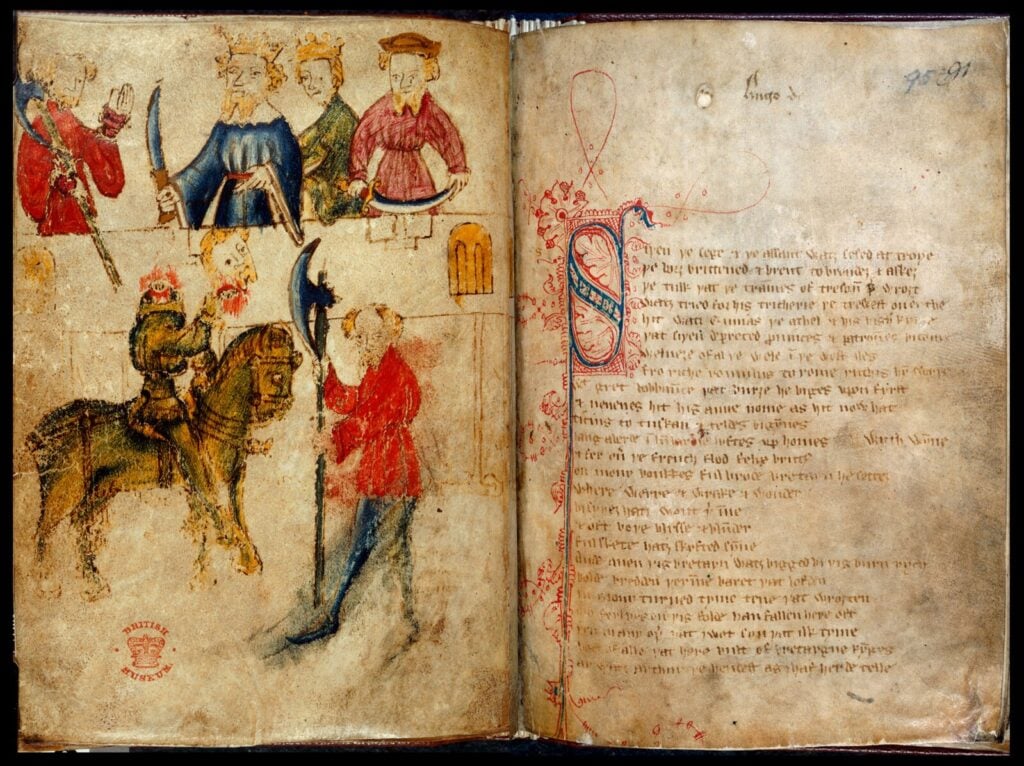Previously: Capelobo.
Type: IR (Immortal Regent). However, it should be noted that subject also displays qualities characteristic of PE (Preternatural Entity) and CC (Corporeally Challenged) classifications.
Period/location of origin: Pre-Christian era, Wales. The precise date of origin of subject — called in Welsh the Brenin Llwyd; in English, the Grey King (from brenin, “king,” and llwyd, “grey”); and, on occasion, the Monarch of the Mist — is unknown, but what we do know is this: Subject is very old, indeed.

Subject is, in fact, ancient.
Appearance: Subject is, as its various monikers might suggest, a male-presenting humanoid frequently described as appearing dressed in grey robes and/or a grey cloak and wreathed in grey clouds and mist. Beyond this, however, little has been recorded of subject’s appearance — or much else of subject, for that matter (e.g. activities, etc.) — or else simply is no longer extant. As such, further details regarding subject’s physical aspect are unavailable.
Occasionally, subject may be described as slightly more monstrous in appearance than humanoid; more than once in recent years, subject has even been compared to Bigfoot, yetis, and other such beings. However, it is not clear from whence this equivalence has been drawn; the earlier documentation we do have of subject do not make any mention of fur, hair, or other beast-like characteristics.
Modus operandi: Although subject rarely, if ever, ventures outside of Wales, subject’s modus operandi may differ depending on the precise region in Wales in which it is encountered.
In the north, subject has been known to roam primarily around the Snowdonia or Eryri region, particularly the mountain known as Snowdon or Yr Wyddfa — the highest mountain in Wales — as well as around Cadair Idris in the Meirionnydd region and Plynlimon in the Cambrian Mountains. Snowdon and Cadair Idris are both located within what is now Snowdonia National Park, or, in Welsh, Parc Cenedlaethol Eryri.
Any humans who may wander into or among these mountains become targets. Should subject identify such targets, it may track, stalk, and subsequently… take targets.

It is not known what subject does with targets once they have been acquired.
This is because those targets are never seen again.
In the south, primarily in and around the South Wales Valleys, subject is often described as “hungering” for targets. Whether or not this is literal or figurative remains unclear; it does, however, imply that in this region, subject may actively hunt for targets, as opposed to capturing them simply whenever they wander a bit too close to subject.
Stories of subject have also been used in this region as cautionary tales: Children and adults alike are warned not to go too far or too high up into the mountains of the area, or else subject will get them.
In all reports, subject is typically silent, both in movement and in speech, as well as only semi-corporeal. This makes it difficult to avoid encounters with subject, should targets venture too near; by the time targets have realized that subject is upon them, it is… too late.
Containment: There is no containing the Monarch of the Mist.
Additional notes: Although subject on its own is not spoken of now with the same degree of frequency as it once was, connections have been drawn between subject and other, more notable figures, tales, and stories.
Of these, perhaps the most significant is the 14th century chivalric romance Sir Gawain And The Green Knight. This narrative poem sees Gawain of Arthurian legend, prior to his becoming a Knight of the Round Table, accepting a challenge from a figure initially described only as a “Green Knight” and subsequently engaging in a “beheading game” — a trope commonly found in Celtic mythology dealing in the exchange of blows between a hero and a mysterious figure and representing a coming of age for the hero.
In Sir Gawain And The Green Knight, the “Green Knight” who initially issues the challenge is later revealed to be Bertilak de Hautdesert, lord of the castle Gawain stops at on his way to the Green Chapel to complete the challenge.
It has long been established that Sir Gawain And The Green Knight’s beheading challenge sees its origins in an Irish legend, Fled Bricrenn or Bricriu’s Feast. But in his 1943 article “More Celtic Elements In ‘Gawain And The Green Knight,’” published in the Journal of English and Germanic Philology, medievalist Roger Sherman Loomis posited that several distinct elements of the poem have their origins in Welsh sources — among them the character of the Green Knight/Bertilak himself. Bertilak may, according to this argument, consist at least in part of an interpretation of elements of the Brenin Llwyd legend.

It is worth noting at this point that, as Alice Buchanan underlined in her 1932 article “The Irish Framework Of Gawain And The Green Knight,” published in the journal PMLA, that the moniker of the Green Knight itself might be a misinterpretation of an Old Irish word. The word “glas” has been found in some texts pertaining to the Green Knight — the word itself carrying a double meaning: In some circumstances, it may mean “green,” but in others, it is “grey.” That is, the Green Knight may not be green at all, but grey.
Other mythological figures to which subject has been likened include the Welsh psychopomp Gwyn ap Nudd; the giant of Cadair Idris; and the Scottish Am Fear Liath Mòr, or Big Grey Man.
More recently, Susan Cooper’s The Dark Is Rising Sequence utilized the Brenin Llwyd as one of its many influences. First published between 1965 and 1977, this five-book series draws heavily from Celtic and Norse mythology, English folklore, and Arthurian legend; indeed, the fourth book in the series, The Grey King (first published in 1975), features an antagonist directly drawn from — and referred to as — the Brenin Llwyd. The Grey King was awarded the Newbery Medal for its significance as a “distinguished contribution to American literature for children.”
Recommendation: Don’t go into the mountains alone.
Don’t go into the mountains too late.
Don’t go into the mountains too high, or too far.
Just… don’t go into the mountains.
Not if you can help it, at least.
Resources:
Folklore And Folk Stories Of Wales by Marie Trevelyan.
“Brenin Llwyd: The Enigmatic Grey King of Welsh Folklore” at Americymru.net.
“The Grey King” at Ceri John Phillips’ Substack.
Time Between Times podcast, episode 11: “Y Brenin Llwyd.”
“If You Can Keep Your Head — Thoughts On The Beheading Game” at Story Archaeology.
Sir Gawain And The Green Knight at Project Gutenberg.
“More Celtic Elements In ‘Gawain And The Green Knight’” by Roger Sherman Loomis (Journal of English and Germanic Philology).
“The Irish Framework Of Gawain And The Green Knight” by Alice Buchanan (PMLA).
The Dark Is Rising Sequence by Susan Cooper.
[Photos via Siaron James, Father.Jack/Flickr, available under a CC BY 2.0 Creative Commons license; Wikimedia Commons, available via the public domain]
Leave a Reply